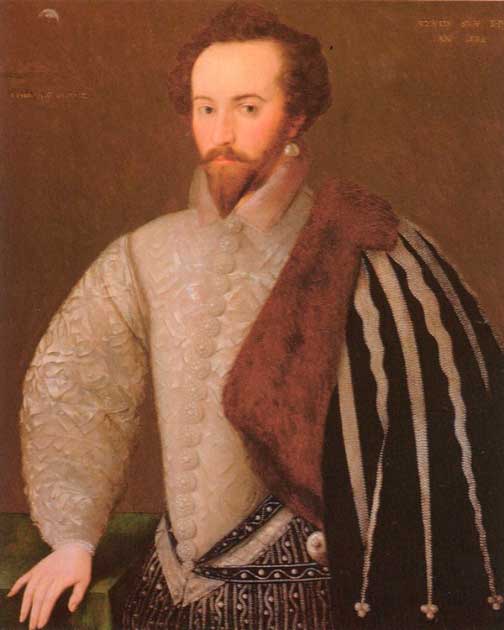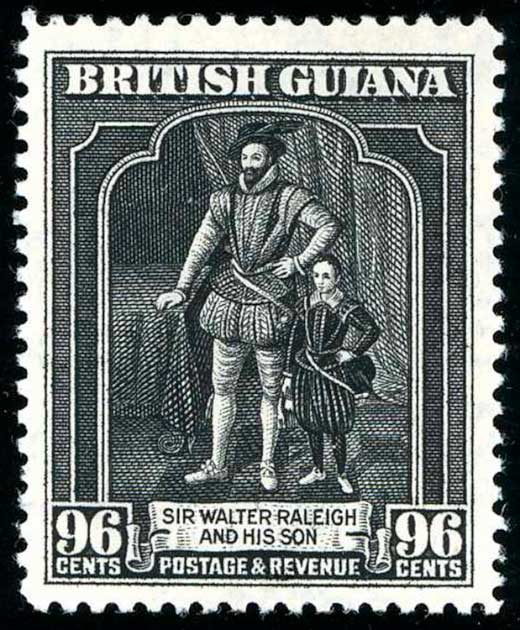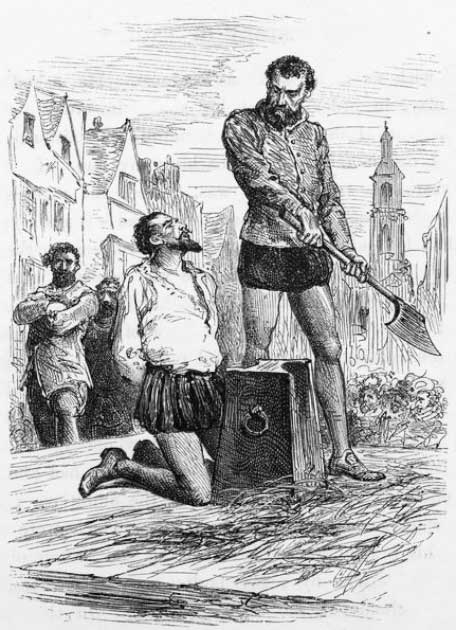Queen Elizabeth I of England was known to have favorites. Whether it was Robert Dudley in her youth or the Earl of Essex in her maturity, the Virgin Queen was known to extend her patronage to those whom she preferred, and make their fortunes in the process.
And so it was with Sir Walter Raleigh, considered one of the most significant figures of the Elizabethan era. He was a soldier, writer, English statesman, poet, and explorer who sponsored early American colonization.
Yet this favorite courtier of Queen Elizabeth I was imprisoned in the Tower of London not once, but twice during his lifetime. Worse, Sir Walter Raleigh was ultimately sentenced to death for treason and beheaded.
How could someone so dynamic as Sir Walter Raleigh get imprisoned twice and then beheaded when he was once a confidant of the Queen of England? Who was Sir Walter Raleigh, and what happened to him?
Sir Walter Raleigh
Sir Walter Raleigh (sometimes spelled Ralegh) was born in Devon, England, in 1552. He had several notable relatives: his half-brother was the explorer Sir Humphrey Gilbert, and his other half-brother John Gilbert was the vice admiral and sheriff of Devon.
His mother’s aunt was the governess of Queen Elizabeth before she ascended to the throne, and another aunt was related to the Boleyn family. But despite these connections and his high birth, not much is known about the early years of Sir Walter Raleigh beyond the fact that he was a very devoted Protestant.
In 1569, Raleigh went to France in order to serve with the Huguenots (Protestants) at the Battle of Jarmac during the French Wars of Religion. Once he returned to England, he then took part in the suppression of the Desmond Rebellions in Ireland.
He was present during the Siege of Smerwick in Munster, Ireland. During the siege, Raleigh was said to have led a group of soldiers that beheaded around 600 Italian and Spanish soldiers. These seemingly heroic actions caused Queen Elizabeth I of England to notice him, and he was soon called to her court.

Sir Walter Raleigh made an excellent impression on Queen Elizabeth partly due to his valor and good looks. A legend about Sir Walter Raleigh was that he placed his cloak over a puddle so the Queen could walk across without getting her feet wet.
- Did Queen Elizabeth Murder Robert Dudley’s Wife?
- The Duke of Buckingham: Was Dumas’s Hero also James I’s Lover?
While that probably is little more than a legend, we know the Queen loved Sir Walter Raleigh’s poems and company. Not long after being welcomed into the Queen’s inner circle, Raleigh was knighted and became a Member of Parliament. Further illustrating Elizabeth’s affection for Sir Walter Raleigh, in 1587, he was made the Captain of the Queen’s Guard.
As the favorite courtier of Elizabeth I, Sir Walter Raleigh’s finances and honors continued to grow. He convinced the Queen that creating colonies in North America would challenge Spanish authority, an idea the Queen found appealing.
However, because he was her favorite, he was forbidden from traveling to the colonies. Instead in 1584, 1585, and 1587, Sir Walter Raleigh organized and funded several voyages to North America. This led to his sponsorship of a colony named Virginia after the Queen on Roanoke Island in the Outer Banks area of North Carolina. Elizabeth was known as the “Virgin Queen” because she was never married or had children, hence the name Virginia.
The First Imprisonment
Sir Walter Raleigh first fell from the Queen’s good graces once she learned of his secret marriage to one of her ladies-in-waiting. In a fit of rage, the Queen sentenced both Raleigh and his wife to the Tower. Many believe that he was punished because he was a lover of the Queen, who was jealous he had found another. This belief adds more to the reputation of Sir Walter Raleigh, but is probably untrue.
Ladies-in-waiting tended to be young members of the nobility who would learn how to behave at court, and how to serve the Queen. The Queen would then arrange marriages for the girls with other nobles, matches made usually for dynastic or political reasons.
The unapproved secret marriage and the news that his new wife was pregnant made Elizabeth angry. The two didn’t remain locked in the Tower for very long however, and a few years after release, Sir Walter Raleigh was once again in the Queen’s favor. This led the Queen to approve a royal charter for Raleigh to create the first English colonies in America, which resulted in the famous Lost Colony of Roanoke.
Although the colony of Roanoke was a massive failure, he was still able to gain permission to mount an expedition to find the legendary city of gold, El Dorado, which was believed to be in Guyana in South America. Upon his return to England, Raleigh wrote about how Guyana was a paradise.
He said the ground was covered in gold and the indigenous peoples wanted to be ruled by the English. While this was an exaggerated and largely fictitious account, it did serve as motivation for further voyages to be funded by other royals besides the Queen.

There is a legend that Sir Walter Raleigh brought the potato and tobacco to England upon his return from South America. This is not true, and there has been historical evidence indicating the potato did previously exist in England but not as a popular food. Along with the potato myth, Sir Walter Raleigh did not bring tobacco to England. What he did do was increase its popularity and made claims it could cure coughs.
The Second Fall From Grace
After Queen Elizabeth’s death, James VI of Scotland ascended the English throne as James I of England. James did not share the same admiration for Sir Walter Raleigh that his predecessor had shown.
- Sir Francis Walsingham: Who was Queen Elizabeth’s Spymaster in Chief?
- Why Some Think Queen Elizabeth I Was A Man
In 1603, with the new king barely crowned, Sir Walter Raleigh was implicated in a conspiracy known as the Main Plot. The plot was that James I was to be overthrown and replaced by his cousin Lady Arabella Stuart.
The rumors stated that the 11th baron of Cobham, Henry Brooke, was conspiring with a Dutch prince who would supply Brooke with large sums of money from Spain to finance the coup d’etat. Brooke was allegedly supposed to bring the money back to England by way of the Channel Island of Jersey. The governor of Jersey was Sir Walter Raleigh, and the two would work together to overthrow the king.
The allegations were preposterous. The idea of Sir Walter Raleigh, who was known to hate the Spanish, agreeing to accept money from Spain to act against the English crown was laughable. The trial of Sir Walter Raleigh was essentially a sham.
James I, who had been trying to end the fighting between Spain and England, saw an opportunity for political advantage and sentenced Raleigh to death. He was locked in the Tower of London for the next thirteen years. Sir Walter Raleigh lived in the Tower with his wife and children and wrote a book, expansively titled History of the World, in 1614.
Raleigh was pardoned in 1617, so he could return to Guyana to find El Dorado and bring back the gold he claims to have found to King James. This was likely caused by the exaggerated claims Raleigh wrote about from his first voyage to Guyana.
This trip was a disaster and the final nail in Sir Walter Raleigh’s coffin. Some of Raleigh’s men separated from the group and attacked a Spanish outpost along the Orinoco river, against Raleigh’s orders. While Raleigh hated Spain for their religious persecution of Protestants, part of his pardon was a condition that he was not to attack any Spanish forts, posts, or ships while in South America.
The Execution Of Sir Walter Raleigh
When Raleigh returned from Guyana, the Spanish ambassador in England demanded that King James reinstate Raleigh’s death sentence from 1603. King James, who still wanted to be on Spain’s good side, honored the demands of the Spanish ambassador. On October 29, 1618, Sir Walter Raleigh was executed in the Palace Yard at the Palace of Westminster.

Before the executioner struck Raleigh, he was said to have taunted him, saying, “What dost thou fear? Strike man, strike!” A bag of tobacco was found in his prison cell following his execution.
Engraved upon the bag was Comes meus fuit in illo miserrimo tempore, which translates to “It was my companion in that most miserable time.” After his execution, his head was embalmed and given to his wife. He was eventually buried in The Church of St. Margaret, Westminster, where his tomb remains to this day.
Top Image: Sir Walter Raleigh by Nicholas Hilliard. Source: Nicholas Hilliard / Public Domain.
By Lauren Dillon